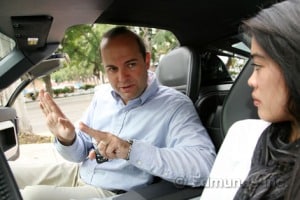Busting the Myths of Driving a Manual Transmission
 Edmunds.com
Member, Administrator, Moderator Posts: 10,316
Edmunds.com
Member, Administrator, Moderator Posts: 10,316
 Busting the Myths of Driving a Manual Transmission
Busting the Myths of Driving a Manual Transmission
After having to pay $2,000 for a new clutch and flywheel, Edmunds employee Julie Sun turned to Editor in Chief Karl Brauer for some guidance on the correct way to drive stick. | March 18, 2010 | Eric de los Prados for Edmunds
0

Comments
Apart from that, unclutching to brake lenghtens your braking distance, and lessens your control over your vehicle, which can be quite important for young drivers.
And, before tarting about costs, you may want to think about this:
A car with a busted clutch will not start.
A car with busted brakes will not stop.
In what situation are you most likely to walk away unharmed?
(I didn't count the handbrake here, while it's certainly a decent safety measure, I think that, when present with broken brakes, few people would react in time, myself included)
That said, I think that people that want to use a MT, need to pass a test for it. Those people will not bust their clutch so easily, and it will cause less conflicts with car dealers claiming you broke the clutch because you can't use it.
Line locks have been used for several decades on drag-racing vehicles to lock the non-driven wheels to facilitate a power "burn-out" to heat the driven wheel tires.
I would amend the advice slightly to say that, yes, when you need the clutch, make sure it's pushed all the way in or completely released. However, if you won't need the clutch in the next 2-3 seconds, shift to neutral and release the clutch.
Regarding greater wear on the engine rotating parts due to downshifting that was made by one commenter, I say hogwash! Sure if you downshift at too high of RPMs and cause the engine to rev too high, than sure it could be a problem, but normal downshifting does not cause greater engine wear. I've had several manual transmission cars that had well in excess of 100,000 miles and had no tell-tale signs of wear (knocks, ticks, or other engine noises). In fact, the only 2 cars that ever developed engine issues (bad rod bearing in one, bad wrist pin in the other) were both automatics.
So in my driving experience of 38 years, I'd have to say manual transmissions have done well be me. I do enjoy the convenience of an automatic sometimes, and I certainly prefer them for pulling a trailer, but overall manuals have provided better gas mileage, not to mention have done better by me in snowy or icy road conditions.
The point the connecting rods and crankshaft are DESIGNED for high loads... if you think using the engine for breaking puts a load on them imagine how much of a load they get from hard acceleration!
In a car generally using the engine as a brake is more trouble than it's worth, and I rarely do it, however when driving downhill in the mountains downshifting and letting the engine help keep your speed down is the smart thing to do.
I had a 2010 V6 Accord with the manual transmission, it had major engine issues every six months and when it finally had major damages as a result of poor manufacturing...Honda decided to deny repairs claiming "user abuse" (which was never observed - previously or at the time of final break down). They just decided not to repair it and bet that I couldn't afford to fight it.
State Lemon Law Board eventually ordered Honda (unanimously) to buy it back, but the process takes six months on average.
This article is completely irresponsible and should be reviewed by your legal staff. Seriously, how could you post such poor advice?
One more thing .. a Myth 6 "Its ok to sit at a stoplight with the car in gear and the clutch pushed in"
The throwout bearing is dry with no active lubrication. If you keep it under load and spinning at stoplights it will wear out much sooner. Replacing this bearing is the same labor cost as replacing the entire clutch.
I leave the car in neutral at stoplights, when I see that the light is about to turn green, I press the clutch and put it in gear to prepare for takeoff.
This is absolutely FALSE:
"Whenever the clutch pedal isn't all the way up or all the way down, you're putting wear on your clutch"
Lie. Any time the clutch is depressed sufficiently to cause plate slippage under a significant load, yes, but that unqualified statement is FALSE>
next lie:
" it's important to "rev-match." "
FALSE> Only in a non synchronized transmission
Lets see what other lies are passed off as "I know it all"
........
next false statement:
"The most important rule, however, is never use the clutch to hold your car in place while waiting on an incline. Doing this will burn out that imaginary red light on the dash — as well as really burn out the clutch."
FALSE. Again, another highly conditional situation where an idiotic Author wishes to play know it all and make a false, grand, sweeping overgeneralization.
What about a very shallow hill where the clutch is just slightly engaged for a few seconds? that will not "burn it out"
Folks, when you see huge sweeping overgeneralizations like this, just assume the Author is an idiot, this one is.
Signed, AUTOMOTIVE ENGINEER.
wish I had another one, better on gas too.
used the clutch to hold it on hills (takes practice) and always used the transmission to downshift to slow down along with the cars weight. (old truck driving trick).
besides automatics were always a lot more in the cost of the car.
Do they even put manuals in cars anymore?
Rule A - Keep the clutch FULLY engaged as much as possible.
Rule B - When the clutch must be disengaged, it will be FULLY disengaged except for Rule C.
Rule C - Slip the clutch as little as possible when starting off, up-gearing or down-gearing.
That's it. Three simple rules. It's that easy.
Americans REALLY need to understand how to drive a manual shift.
Clutches will eventually wear out even with the most careful and knowledgeable driver as will automatic transmissions. I've driven cars until they were well past time to replace with no clutch problems, but I've also had clutches fail as well as automatics. In general the clutches were cheaper to fix than the automatics and you don't have to worry about intercoolers failing on high mileage cars and running radiator fluid into the manual transmission. That can be really expensive. Voice of experience!
I decided it was cheaper to pay the premium in lower gas mileage since an automatic will last for as long as an engine nowadays than it is to replace even one clutch.
Ever try finding a driving school that will both teach MT and provide the vehicle? I did. They don't seem to exist.
I love mt,s more power and better gas milage the only time tm,s are bad is in heavy traffic start and stopping gets to you after awhile
Go to a flat empty parking lot. Just concentrate on the clutch. Forget about the gas pedal. The student should just learn where the clutch engages and how to slowly let it out. The car will move forward without stepping on the gas at all. Once they get the clutch mastered, then add in the gas pedal. Two easy lessons and they were driving on roads.
With an automatic ; you can 't let the engine run a little slower , going up hills , because it is downshifting ; and revving the engine .
A stick ' ; lets you lower your RPM 's ; go a little slower going up ; and then let it go faster ', going down ' ,making up the time you lost , and helps improve your mileage .
With an automatic ; you can 't let the engine run a little slower , going up hills , because it is downshifting ; and revving the engine .
A stick ' ; lets you lower your RPM 's ; go a little slower going up ; and then let it go faster ', going down ' ,making up the time you lost , and helps improve your mileage .